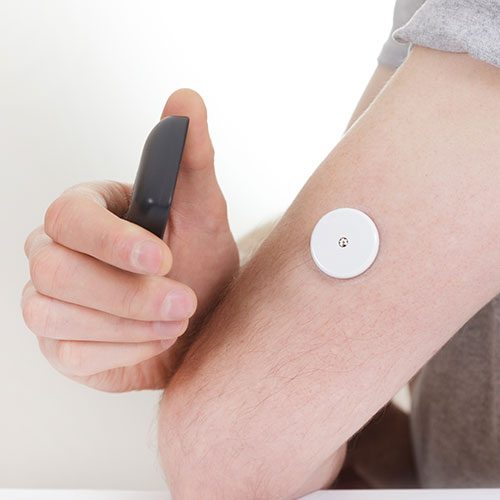Pre-diabetes

Pre-diabetes
Pre-diabetes is diagnosed when blood glucose levels (BGLs) are more elevated than usual, but not elevated enough for a person to be diagnosed with Type 2 diabetes. There are two different types of pre-diabetes; “impaired glucose fasting” (IGF) and “impaired glucose tolerance” (IGT). In some cases, both impaired glucose tolerance, and impaired glucose fasting are evident.
If you have had an elevated BGL, or your doctor suspects you may be at risk of pre-diabetes, an oral glucose tolerance test (OGTT) is ordered. Impaired glucose fasting is diagnosed if a person’s fasting BGL is elevated in the morning, despite not having anything to eat overnight. Impaired glucose tolerance is diagnosed if your BGL remains higher than usual 2 hours after an OGTT.
What to do next?
If left untreated, Pre-diabetes may progress into Type 2 diabetes. There are various lifestyle changes a person can make to help reduce the risk of developing type 2 diabetes. These include, weight loss, a healthy diet and regular exercise. These changes can also help lower blood pressure and improve cholesterol, lowering the risk of heart disease.
Please contact Hobart Diabetes Health if you would like to make an appointment to learn more about pre-diabetes and how to help manage it.
Type 2 Diabetes

Type 2 Diabetes Mellitus (T2DM)
T2DM is the most common form of diabetes. Approximately 1 in 20 Australians are living with diabetes. This equates to around 1.2million people Australia-wide. Of these people, around 85% have T2DM.
How does it develop?
T2DM is a progressive condition that is often undiagnosed for many years. It occurs when the body becomes increasingly resistant to insulin, and slowly loses the ability to produce enough insulin to keep blood glucose levels within a healthy range. As insulin resistance progresses, the body is required to make higher amounts of insulin. This causes a destruction of the insulin making cells as they gradually begin to ‘wear out’ by being ‘over-worked’.
There are specific risk factors associated with developing T2DM. Some of these risk factors are preventable such as elevated body mass index (BMI), inactivity and poor diet. Other non-preventable risk factors include age, ethnicity, genetics and family history.
What to do next?
If you are diagnosed with T2DM, it is important to seek advice as early as possible to reduce the risk of complications. T2DM can sometimes be controlled with lifestyle changes alone, however, as it is a progressive condition, oral or injectable medications may eventually be required to maintain target BGLs.
If you have recently been diagnosed with T2DM, or would like to talk about strategies to help manage your T2DM, please contact Hobart Diabetes Health to make an appointment.
Type 1 Diabetes

Type 1 Diabetes Mellitus (T1DM)
T1DM is an autoimmune condition. It is most commonly diagnosed in people aged under 30 but can occur at any age. Up to 15% of all diagnosed cases of diabetes are T1DM.
How does it develop?
It is not known what causes T1DM. There is strong evidence of a genetic predisposition. Currently, T1DM cannot be prevented nor cured. It occurs when the body triggers an immune response where antibodies destroy the insulin making cells in the pancreas, known as beta-cells. This leads to a complete insulin insufficiency in the body. The onset of T1DM is usually rapid.
Symptoms include:
- Excessive thirst
- Excessive urination
- Blurred vison
- Shortness of breath
- Nausea and vomiting
- Rapid unintentional weight loss
- Fatigue and weakness
- Headaches
- Mood changes
The only treatment for T1DM is insulin via multiple daily injections or Insulin Pump Therapy. Insulin helps pull glucose into the body’s cells for energy. If the body does not have access to a sufficient amount of insulin to help access glucose, it will seek an alternative source of energy and begin breaking down fat. This leads to a high production of harmful ketone bodies being released into the bloodstream. In a person with T1DM, this can quickly result in Diabetic Ketoacidosis (DKA) – a medical emergency.
What to do next?
Managing T1DM can be complex and feel overwhelming, particularly when you or your family member is first diagnosed. It is essential to have a good network of family, friends and healthcare professionals to support you in your daily T1DM management. Hobart Diabetes Health (HDH) understands each individual is different and has varied needs. HDH aims to work with you in a judgement free environment to help identify and achieve your goals. Please contact Hobart Diabetes Health to learn more, or to make an appointment.
Latent Autoimmune Diabetes in Adults

Latent Autoimmune Diabetes in Adults (LADA)
Like Type 1 Diabetes (T1DM), LADA is also an autoimmune condition that occurs when the body triggers an immune response that causes antibodies to destroy the insulin making cells in the pancreas, known as beta-cells. This eventually leads to complete insulin insufficiency in the body. However, unlike T1DM, the onset is usually much more gradual and people are commonly diagnosed over age 30. Due to this, LADA is often misdiagnosed as Type 2 Diabetes.
Less insulin therapy is usually required when a person is first diagnosed with LADA, compared to T1DM. This is likely due to the body still producing some of its own insulin. There is still a risk of Diabetic Ketoacidosis (DKA) among people diagnosed with LADA, particularly as it develops and further beta-cell destruction occurs.
If you would like to learn more about how to manage LADA or discuss a new diagnosis, please contact Hobart Diabetes Health to make an appointment.
Gestational Diabetes

Gestational Diabetes Mellitus (GDM)
GDM is a type of diabetes that women can develop during pregnancy. It occurs in around 12-14% of pregnancies, and usually resolves once the baby is born. GDM is diagnosed via an oral glucose tolerance test (OGTT) that is routinely performed when you are between 24-28 weeks gestation.
How does it develop?
During pregnancy, the placenta produces hormones that help your baby to develop. These hormones can block the action of insulin in the body. This is known as “insulin resistance”. Due to this insulin resistance, the body is required to produce up to three times the usual amount of insulin. If the women’s body is unable to produce this amount of insulin, blood glucose levels will rise, leading to GDM.
Hobart Diabetes Health (HDH) understands being diagnosed with GDM can be upsetting and feel overwhelming. It is important that you are well supported throughout your pregnancy to help you have a normal delivery and a healthy baby. GDM can often be successfully managed with dietary changes and exercise alone, however, some women may require medication and/or insulin to keep their blood glucose levels within a healthy range.
What to do next?
If you are diagnosed with GDM, it is important to see a health care professional specialising in GDM within one week. Please contact Hobart Diabetes Health if you would like to make an appointment.
Further information is available at www.ndss.com.au/GD
Mature Onset Diabetes of the Young (MODY)

Mature Onset Diabetes of the Young (MODY)
MODY is different from both Type 1 Diabetes Mellitus (T1DM) and Type 2 Diabetes Mellitus (T2DM) and much more rarely diagnosed. It is often misdiagnosed as T1DM or T2DM as the clinical features can be very similar. MODY occurs more frequently in people who are under the age of 25, have a strong family history of diabetes, and in those who are from European and Asian backgrounds.
The most common cause of MODY is a molecular genetic mutation. This affects the way insulin is produced and secreted by the pancreas in order to keep blood glucose levels (BGLS) within a normal range. In some forms of MODY, the pancreas does not release insulin as BGLs rise, even though it is still capable of making insulin.
MODY is diagnosed via molecular genetic testing, however this testing can be very expensive and not widely available. There are specific criteria and clinical features your doctor will look for if a diagnosis of MODY is suspected. Sometimes oral medications alone are enough to maintain target BGLs. In other cases, individuals may require insulin.
Please contact Hobart Diabetes Health if you would like to learn more about MODY and current National Diabetes Service Scheme (NDSS) subsidies for diabetes related technologies, such as continuous glucose monitoring systems (CGMS).
Steroid Induced Diabetes

Steroid Induced Diabetes Mellitus (SIDM)
Steroids are necessary for treating a wide range of autoimmune and inflammatory conditions. However, steroids can cause the body to be more resistant to insulin leading to a rise in blood glucose levels (BGLs). This requires your pancreas to produce higher amounts of insulin. If your body is unable produce more insulin, insulin injections maybe required to help keep BGLs within a healthy range.
Anyone taking steroids is at risk of developing SIDM, though there are certain factors that can increase your risk. These include, being above the age of 50, increased BMI, family history of diabetes, ethnicity, and taking other medications that also cause insulin resistance, such as some psychiatric and antirejection drugs.
If you would like to know more about the diagnosis and management of SIDM, please contact Hobart Diabetes Health to make an appointment.
Cystic Fibrosis Related Diabetes

Cystic Fibrosis Related Diabetes (CFRD)
CFRD is different from other types of diabetes. Cystic Fibrosis involves mutations to a gene that causes sticky, thick mucus secretions in multiple organs, including the pancreas where insulin is made. CFRD occurs in around 30% of people living with Cystic Fibrosis (CF), usually by the age of 25. Oral medications are often not effective in treating CFRD and insulin therapy is recommended if BGLS are persistently above target range.
CFRD is complex and often exacerbated by recurrent chronic illness ‘flare-ups’. These ‘flare-ups’ may require the necessary use of steroids, causing the body to be more resistant to insulin. People with CF also require a very high calorie diet because of increase resting energy requirements and malabsorption. Supplementary feeds may be required to maintain an adequate daily calorie intake. This subsequently increases the demand for insulin. As a result, the treatment regime required for managing CFRD will often vary from day-to-day.
Please contact Hobart Diabetes Health if you would like to learn more about CFRD, and current National Diabetes Service Scheme (NDSS) subsidies for diabetes related technologies such as continuous glucose monitoring systems (CGMS).

